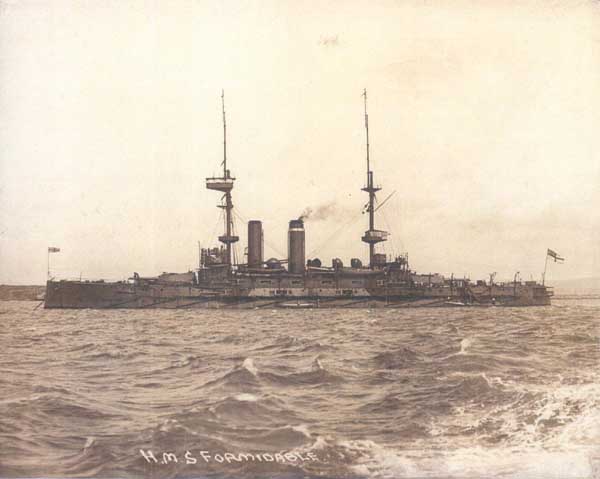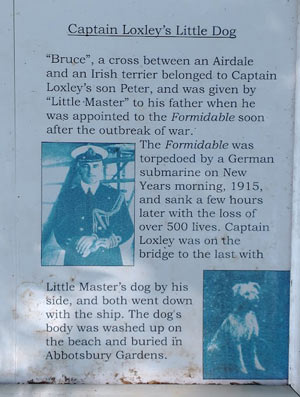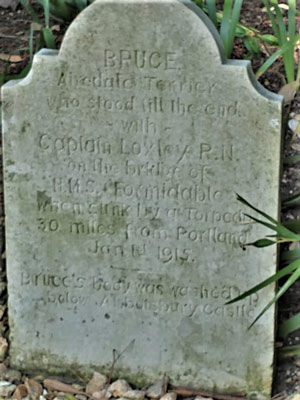The Story of the Sinking of HMS Formidable
Information & photograph kindly provided by the Lyme Regis Philpot Museum - a large display centred on the sinking can be seen at the museum.

HMS Formidable, 15,250 tons, pre-Dreadnought Battleship, launched in 1898, first commissioned in 1901 and torpedoed by German U-boat 24 on New Year's Day 1915 while on exercises. She sank in 180 feet of water about 37 miles off the Devon coast, the first British battleship to be sunk in the First World War.
Only 199 men were saved out of a complement of about 750.
HMS Formidable was sunk by two torpedoes from a German submarine 20 miles off Start Point at 2 am, 1st January 1915, in the first year of the First World War. The first torpedo hit the number one boiler port side; a second explosion caused the ship to list heavily to starboard. Huge waves thirty feet high lashed the stricken ship, with strong winds, rain and hail, sinking it in less than two hours.
Captain Loxley, his second-in-command, Commander Ballard, and the signaller stayed at their posts throughout, sending flares and rockets off at regular intervals. There was no panic, the men waiting calmly for the lifeboats to be lowered. Someone played ragtime on the piano, others sang. The Chaplain, (Revd. G Brooke Robinson who was formerly Curate of Burton Bradstock) went down with the ship by risking his life going below to find cigarettes. Suddenly the ship gave a tremendous lurch, the Captain shouted 'Lads, this is the last, all hands for themselves, and may God bless you and guide you to safety'. He then walked to the forebridge, lit a cigarette and, with his terrier Bruce on duty at his side, waited for the end, in true Royal Naval tradition.
The piano was thrown overboard: many of the boats were smashed as they were lowered into the water, killing all occupants, or else were swamped and sank. 'A piano's better than now't', said one. One pinnace with 70 men on board was picked up by the trawler Provident, 15 miles off Berry Head. The second pinnace took off another 70 men. This boat was soon half-filled with water as the men desperately bailed - with boots, caps, even a blanket, anything that came to hand. One seaman sat over a hole in the boat from the time they started away to the time of rescue. The enormous swell was terrifying, but morale was kept up by any means, humour, singing, even bullying. Petty Officer Bing admitted punching men who wanted to give up. The survivors unanimously agreed they owed their lives to Leading Seaman Carroll, coxswain, who continued to cheer and inspire, not allowing them to sink into despair. Dawn broke out of sight of land; a liner was seen, then eleven other craft, but the pounding seas and huge waves hid the pinnace. Night came, still with relentless gales.
Blackout restrictions were in force, and there are two explanations for the seamen seeing light from the shore. Petty Officer Bing saw a red light seven miles away which could have been the Lyme harbour light. The other explanation from J H Taplin, another survivor, was that a sudden bright light shone out three miles off, which may have been from the Assembly Rooms cinema. The machine had broken down and the operator examining it shone the lamp through the window for a second or two.
The pinnace was first seen at Lyme by Miss Gwen Harding and her parents walking home along Marine Parade after dining out with friends. She glimpsed the outline of a boat, her mother confirmed her suspicions and the alarm was raised. So began the rescue. Of the 71 men in the pinnace, 48 were brought ashore alive, six were found to be dead on arrival, 14 died during the 22 hours the men had fought for survival and were buried at sea, and three died after landing.
The Pilot Boat Inn (Mrs. Atkins the landlady took many survivors in. Her dog Lassie drew attention to Seaman Cowan, laid on the floor for dead, by licking his face) became rescue headquarters. Many of the townsfolk brought food and blankets. Others took men into their homes to rest and recuperate, while those needing medical aid were sent to hospital. The dead were placed in the entrance to the cinema, a part of the old Assembly Rooms.
Ken Pett
December 2008 - New information
The Rev. Bob Thorn recently received a letter from Patrick Kenny who thought we should put the record straight about the chaplain of this boat who is described above as " going down with the ship after risking his life going below to find cigarettes" . Tom Walker, was a survivor of the sinking, and over the years told Mr. Kenny his story of survival and he felt that he would not have lived had it not been for the Chaplain's example and assistance. Mr. Kenny read our story on the web site and felt it his duty to relate Tom's story as follows:-
Tom was 18 years at the time. He had recently been advanced to able seaman and received 'back-pay' that included a new gold sovereign. He was keeping this for his mother, in his kit locker, between decks.
On the night of the sinking Tom was on deck. He remebers it being 'a bright moon-lit night'.
On the quaterdeck he joined the men waiting to go to the boats. Oddly, a few of them were reluctant to leave the ship; Tom shared this feeling:- leaving his sovereign behind may have been an influence! He decided to set off for his kit-locker.
Between decks the illumination was poor; this, coupled with the ship's erractic movements, made the journey slow and tedious. Tom had "thoughts" about this predicament........
He returned to the quaterdeck to find it deserted. The boats had left the ship. One boat was still quite close- he could not recognise people's faces. Why did they not acknowledge his shouts and waves? They were determinably pulling away from the ship. He was alone.
.....As if in answer to a prayer. The ship's Chaplain arrived on the quaterdeck. A huge feeling of relief ensued. Thankfully the Chaplain seemed to know intuitively, what the best to do. "Stay on the ship. Wait for their escort to come to them". He was confident that his friend- the First Leiutenant of one of the escort cruisers, would get to them when he discovered that he (the Chaplain) was missing. The Chaplain had officiated at this officer's wedding; Tom thought they may have been brothers-in-law.
.......the weather continued to deteriorate. The ship was, by now, low in the water- heaving and wallowing in rough seas. The starboard side three parts under water; holding fast on the quaterdeck was precarious. They awaited the moment they dare scramble up to the port guardrails, onto the port side, then, as the ship 'turned turtle', clambered onto the ship's bottom. They rested there for a few minutes, then struck out into the sea and held onto a wooden boom that came within range.
It was at this time that the ship's propeller struck Tom's left ankle. He felt the blow, not the pain. He hoped that there was still a foot at the end of the leg. They set about securing themselves to the boom, as best they could.
Large amounts of air from the ship, surfaced near them. Their attempts to paddle a safe distance away proved futile; then, as if to please , the ship glided away and disappeared from sight.
What now?...Keeping heads above waves.....Keeping each other awake.....Shouting, singing-(hymns)...Compalining...Praying...Waiting...Hoping...
Dawn was barely noticeable, visibility was poor, sleep beckoned, moral bottomed. Where-o-where is that b...y escort?
Rescue came when they had been in the water for over 14 hours. They were unaware of the escort's arrival. Tom thought he was dreaming...Someone was shouting..."Formidable...Formidable...Formidable " quite close to them. He looked up to see the escort's 'welcome party' looking down on him from the deck.
Lines were thrown to them. Tom had difficulty detaching himself from the boom. He managed to secure himself to a line and was hoisted on board the escort.
On board Tom was bundled down to the mess deck and rubbed dry on a mess table. The doctor assured him that his left foot was still there, he would soon be in hospital.
Later he was taken up and put in a bunk in an officer's cabin. He refused a tot of rum offered him (having promised his mother never to drink!). He was left undisturbed until the following day.
Alongside at Portsmouth he was questioned by two officers - the Captain and, owner of the bunk...the First Lieutenant.
Anti-submarine orders had prevented the escort from either stopping or lowering a boat for them.
Sadly, HMS Formidable's Chaplain was not rescued. The large swell running at the time had taken him under the ship. He was not seen again.
Postscript. Tom Walker was discharged "medically Unfit for Naval Service" in April 1915. He received and "Honourable Discharge" certificate signed by HM George V. He joined the army in 1917, served in France and post-revolution Russia (builing rail tracks) In W.W. II he served with the B.E.F. and later as an Unexploded Bomb Disposal Officer.
He died in Padstow in 1970.
Ray West
In 2021 Simon Cains has added the following poignant information.
The Captain's dog was washed ashore and is buried in the pet cemetery within the Abbotsbury sub-tropical gardens, with an information board.
 |
 |